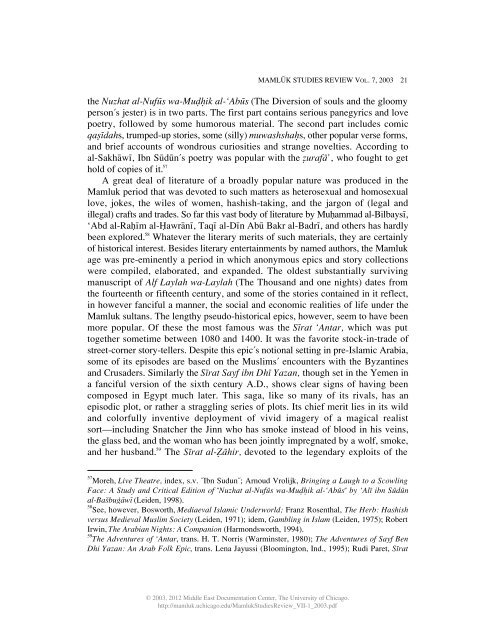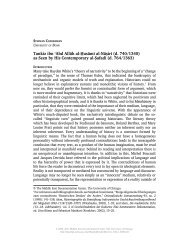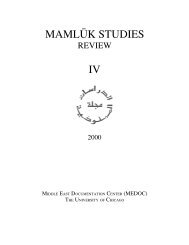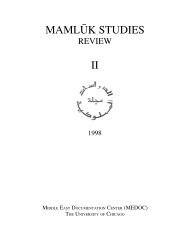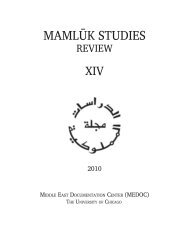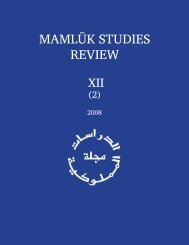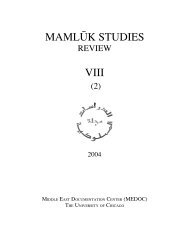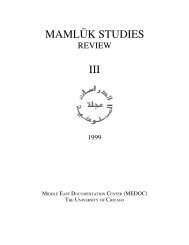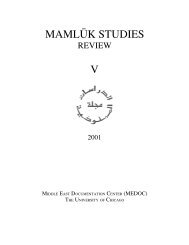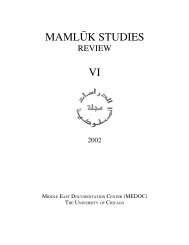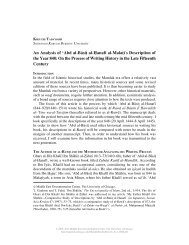Vol. VII, no. 1 (2003) - Mamluk Studies Review - University of Chicago
Vol. VII, no. 1 (2003) - Mamluk Studies Review - University of Chicago
Vol. VII, no. 1 (2003) - Mamluk Studies Review - University of Chicago
Create successful ePaper yourself
Turn your PDF publications into a flip-book with our unique Google optimized e-Paper software.
MAMLU±K STUDIES REVIEW VOL. 7, <strong>2003</strong> 21<br />
the Nuzhat al-Nufu≠s wa-Mud˝h˝ik al-‘Abu≠s (The Diversion <strong>of</strong> souls and the gloomy<br />
person's jester) is in two parts. The first part contains serious panegyrics and love<br />
poetry, followed by some humorous material. The second part includes comic<br />
qas˝|dahs, trumped-up stories, some (silly) muwashshah˝s, other popular verse forms,<br />
and brief accounts <strong>of</strong> wondrous curiosities and strange <strong>no</strong>velties. According to<br />
al-Sakha≠w|, Ibn Su≠du≠n's poetry was popular with the zűrafa≠’, who fought to get<br />
hold <strong>of</strong> copies <strong>of</strong> it. 57<br />
A great deal <strong>of</strong> literature <strong>of</strong> a broadly popular nature was produced in the<br />
<strong>Mamluk</strong> period that was devoted to such matters as heterosexual and homosexual<br />
love, jokes, the wiles <strong>of</strong> women, hashish-taking, and the jargon <strong>of</strong> (legal and<br />
illegal) crafts and trades. So far this vast body <strong>of</strong> literature by Muh˝ammad al-Bilbays|,<br />
‘Abd al-Rah˝|m al-H˛awra≠n|, Taq| al-D|n Abu≠ Bakr al-Badr|, and others has hardly<br />
been explored. 58 Whatever the literary merits <strong>of</strong> such materials, they are certainly<br />
<strong>of</strong> historical interest. Besides literary entertainments by named authors, the <strong>Mamluk</strong><br />
age was pre-eminently a period in which a<strong>no</strong>nymous epics and story collections<br />
were compiled, elaborated, and expanded. The oldest substantially surviving<br />
manuscript <strong>of</strong> Alf Laylah wa-Laylah (The Thousand and one nights) dates from<br />
the fourteenth or fifteenth century, and some <strong>of</strong> the stories contained in it reflect,<br />
in however fanciful a manner, the social and eco<strong>no</strong>mic realities <strong>of</strong> life under the<br />
<strong>Mamluk</strong> sultans. The lengthy pseudo-historical epics, however, seem to have been<br />
more popular. Of these the most famous was the S|rat ‘Antar, which was put<br />
together sometime between 1080 and 1400. It was the favorite stock-in-trade <strong>of</strong><br />
street-corner story-tellers. Despite this epic's <strong>no</strong>tional setting in pre-Islamic Arabia,<br />
some <strong>of</strong> its episodes are based on the Muslims' encounters with the Byzantines<br />
and Crusaders. Similarly the S|rat Sayf ibn Dh| Yazan, though set in the Yemen in<br />
a fanciful version <strong>of</strong> the sixth century A.D., shows clear signs <strong>of</strong> having been<br />
composed in Egypt much later. This saga, like so many <strong>of</strong> its rivals, has an<br />
episodic plot, or rather a straggling series <strong>of</strong> plots. Its chief merit lies in its wild<br />
and colorfully inventive deployment <strong>of</strong> vivid imagery <strong>of</strong> a magical realist<br />
sort—including Snatcher the Jinn who has smoke instead <strong>of</strong> blood in his veins,<br />
the glass bed, and the woman who has been jointly impregnated by a wolf, smoke,<br />
and her husband. 59 The S|rat al-Z˛a≠hir, devoted to the legendary exploits <strong>of</strong> the<br />
57 Moreh, Live Theatre, index, s.v. "Ibn Sudun"; Ar<strong>no</strong>ud Vrolijk, Bringing a Laugh to a Scowling<br />
Face: A Study and Critical Edition <strong>of</strong> "Nuzhat al-Nufu≠s wa-Mud˝h˝ik al-‘Abu≠s" by ‘Al| ibn Su≠du≠n<br />
al-Ba£bug≥a≠w| (Leiden, 1998).<br />
58 See, however, Bosworth, Mediaeval Islamic Underworld; Franz Rosenthal, The Herb: Hashish<br />
versus Medieval Muslim Society (Leiden, 1971); idem, Gambling in Islam (Leiden, 1975); Robert<br />
Irwin, The Arabian Nights: A Companion (Harmondsworth, 1994).<br />
59 The Adventures <strong>of</strong> ‘Antar, trans. H. T. Norris (Warminster, 1980); The Adventures <strong>of</strong> Sayf Ben<br />
Dhi Yazan: An Arab Folk Epic, trans. Lena Jayussi (Bloomington, Ind., 1995); Rudi Paret, S|rat<br />
© <strong>2003</strong>, 2012 Middle East Documentation Center, The <strong>University</strong> <strong>of</strong> <strong>Chicago</strong>.<br />
http://mamluk.uchicago.edu/<strong>Mamluk</strong><strong>Studies</strong><strong>Review</strong>_<strong>VII</strong>-1_<strong>2003</strong>.pdf


